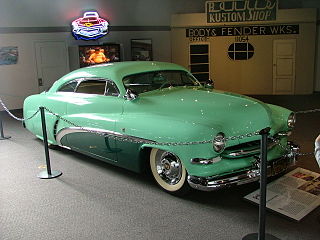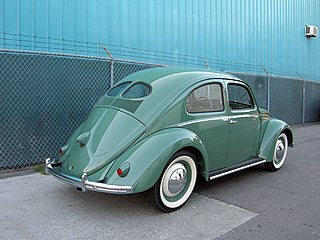
A chassis is the load-bearing framework of a manufactured object, which structurally supports the object in its construction and function. An example of a chassis is a vehicle frame, the underpart of a motor vehicle, on which the body is mounted; if the running gear such as wheels and transmission, and sometimes even the driver's seat, are included, then the assembly is described as a rolling chassis.

A strut is a structural component commonly found in engineering, aeronautics, architecture and anatomy. Struts generally work by resisting longitudinal compression, but they may also serve in tension.

Panhard was a French motor vehicle manufacturer that began as one of the first makers of automobiles. It was a manufacturer of light tactical and military vehicles. Its final incarnation, now owned by Renault Trucks Defense, was formed by the acquisition of Panhard by Auverland in 2005, and then by Renault in 2012. In 2018 Renault Trucks Defense, ACMAT and Panhard combined under a single brand, Arquus.
There are many types of car body styles. They vary depending on intended use, market position, location, and the era they were made.

A structural insulated panel, or structural insulating panel, (SIP), is a form of sandwich panel used in the construction industry.

A car platform is a shared set of common design, engineering, and production efforts, as well as major components, over a number of outwardly distinct models and even types of cars, often from different, but somewhat related, marques. It is practiced in the automotive industry to reduce the costs associated with the development of products by basing those products on a smaller number of platforms. This further allows companies to create distinct models from a design perspective on similar underpinnings. A car platform is not to be confused with a platform chassis, although such a chassis can be part of an automobile's design platform, as noted below.

A sunroof is a movable panel that opens to uncover a window in an automobile roof, allowing light and fresh air to enter the passenger compartment. Sunroofs can be manually operated or motor driven, and are available in many shapes, sizes and styles. While the term "sunroof" is now used generically to describe any glass panel in the roof, the term "moonroof" was historically used to describe stationary glass panes rigidly mounted in the roof panel over the passenger compartment. A moonroof has a glass panel that is transparent and usually tinted. Previous terms include sunshine roof, sliding head, and sliding roof.

Scrap consists of recyclable materials, usually metals, left over from product manufacturing and consumption, such as parts of vehicles, building supplies, and surplus materials. Unlike waste, scrap has monetary value, especially recovered metals, and non-metallic materials are also recovered for recycling. Once collected, the materials are sorted into types — typically metal scrap will be crushed, shredded, and sorted using mechanical processes.

A fuel tank is a safe container for flammable fluids, often gasoline or diesel fuel. Though any storage tank for fuel may be so called, the term is typically applied to part of an engine system in which the fuel is stored and propelled or released into an engine. Fuel tanks range in size and complexity from the small plastic tank of a butane lighter to the multi-chambered cryogenic Space Shuttle external tank.

Sheet metal is metal formed into thin, flat pieces, usually by an industrial process.

A custom car is a passenger vehicle that has been altered to either improve its performance, change its aesthetics, or a combination of both. A desire among some automotive enthusiasts in the United States is to push "styling and performance a step beyond the showroom floor - to truly craft an automobile of one's own." A custom car in British according to Collins English Dictionary is built to the buyer's own specifications.

The trunk or boot of a car is the vehicle's main storage or cargo compartment, often a hatch at the rear of the vehicle. It can also be called a tailgate.
Tower International is a manufacturer of automotive structural metal components and assemblies primarily serving original equipment manufacturers (“OEMs”). Tower International supply body-structure stampings, frame and other chassis structures, and complex welded assemblies for small and large cars, crossovers, pickups, and sport utility vehicles.

The pillars on a car with permanent roof body style are the vertical or nearly vertical supports of its window area or greenhouse—designated respectively as the A, B, C and D-pillar, moving from front to rear, in profile view.

A residential garage is a walled, roofed structure with a door for storing a vehicle or vehicles that may be part of or attached to a home, or a separate outbuilding or shed. Residential garages typically have space for one or two cars, although three-car garages are used. When a garage is attached to a house, the garage typically has an entry door into the house, called the person door or man door, in contrast with the wider and taller door for vehicles, called the garage door, which can be opened to permit the entry and exit of a vehicle and then closed to secure the vehicle. A garage protects a vehicle from precipitation, and, if it is equipped with a locking garage door, it also protects the vehicle(s) from theft and vandalism. Most garages also serve multifunction duty as workshops for a variety of projects, including painting, woodworking, and assembly. Garages also may be used for other purposes as well, such as storage or entertainment.
A glossary of terms relating to automotive design.

In mechanical engineering, stressed skin is a rigid construction in which the skin or covering takes a portion of the structural load, intermediate between monocoque, in which the skin assumes all or most of the load, and a rigid frame, which has a non-loaded covering. Typically, the main frame has a rectangular structure and is triangulated by the covering; a stressed skin structure has localized compression-taking elements and distributed tension-taking elements (skin).

In automotive engineering, the firewall or bulkhead is the part of the automobile body that separates the engine compartment from the passenger compartment. It is most commonly a separate component of the body or, in monocoque construction, a separate steel pressing, but may be continuous with the floorpan, or its edges may form part of the door pillars. The inner and outer surfaces of the firewall are often coated with noise, vibration, and harshness (NVH) absorber to prevent most engine noise from reaching the passenger compartment. The name originates from steam-powered vehicles, where the firewall separated the driver from the fire heating the boiler.

A vehicle frame, also historically known as its chassis, is the main supporting structure of a motor vehicle to which all other components are attached, comparable to the skeleton of an organism.

Conservation and restoration of road vehicles is the process of restoring a vehicle back to its original working condition, whether the car is partially scrapped or completely totaled. Automotive restoration can be applied to many different eras of the automobile. Bus preservation groups aim to purchase buses of various eras to restore them to their original operating condition. Buses are often restored to the original authentic livery of their original owner.

















